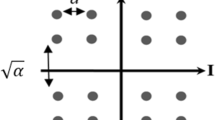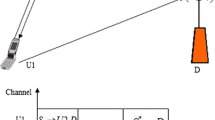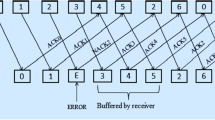Abstract
In the present scenario, with a rapidly growing demand for wireless data, it is time to improve the data rate for a wireless network. "NOMA-ARQ Network" known as "Non-Orthogonal Multiple Access—Automatic Repeat reQuest Network”, is one of the solutions for achieving very low ultra-reliable low latency in network performance. The existing OMA systems require fixed time/frequency synchronization, which is very difficult to meet in practice. In this paper, we propose a comparison between OMA and NOMA. The overall system throughput is evaluated as a function of the number of information bits, channels used, and power. The throughput and outage probability are evaluated as a function of the number of information bits and various block lengths. The performance of the system is analysed in terms of reliability and throughput with the help of the type-1 ARQ protocol. While increasing the number of retransmissions, the reliability of the system gets boosted, thereby reducing the outage probability of reception of an error. Throughout the entire system, the performance of NOMA is found to be better than the OMA.






Similar content being viewed by others
Availability of Data and Materials
Not applicable.
Code Availability
Code Availability on reasonable request.
References
Assaf, T., Al-Dweik, A. J., El Moursi, M. S., Zeineldin, H., & Al-Jarrah, M. (2020). Exact bit error-rate analysis of two-user NOMA using QAM with arbitrary modulation orders. IEEE Communication Letter, 24(12), 2705–2709.
Assaf, T., Al-Dweik, A., El Moursi, M., & Zeineldin, H. (2019). Exact BER performance analysis for downlink NOMA systems over Nakagami-$m$ fading channels. IEEE Access, 7, 134539–134555. https://doi.org/10.1109/ACCESS.2019.2942113
Mukhtar, H., Al-Dweik, A., Al-Mualla, M., & Shami, A. (2013). Adaptive hybrid ARQ system using turbo product codes with hard/soft decoding. IEEE Communication Letter, 17(11), 2132–2135. https://doi.org/10.1109/LCOMM.2013.092813.131480
Mukhtar, H., Al-Dweik, A., & Al-Mualla, M. (2014). CRC-free hybrid ARQ system using turbo product codes. IEEE Transactions Communication, 62(12), 4220–4229. https://doi.org/10.1109/TCOMM.2014.2366753
Mukhtar, H., Al-Dweik, A., Al-Mualla, M., & Shami, A. (2015). Low complexity power optimization algorithm for multimedia transmission over wireless networks. IEEE Journal of Selected Topics Signal Processing, 9(1), 113–124. https://doi.org/10.1109/JSTSP.2014.2331915
Naveen, S. S., Choudhury, S. R. R., & Nelakuditi, S. (2010). Successive interference cancellation: A back-of-the-envelope perspective. IEEE Monterey.
Ding, Z., Lei, X., Karagiannidis, G. K., Schober, R., Yuan, J., & Bhargava, V. K. (2017). A survey on non-orthogonal multiple access for 5G networks: Research challenges and future trends. IEEE Journal on Selected Areas in Communications, 35(10), 2181–2195. https://doi.org/10.1109/JSAC.2017.2725519
Akyildiz, I. F., Gutierrez-Estevez, D. M., Balakrishnan, R., & Chavarria-Reyes, E. (2014). LTE-Advanced and the evolution to Beyond 4G (B4G) systems. Physical Communication, 10, 31–60. https://doi.org/10.1016/j.phycom.2013.11.009
Mohammadian, Z., Dehghani, M. J., & Eslami, M. (2020). Efficient resource allocation algorithms for high energy efficiency with fairness among users in OFDMA networks. Engineering Science and Technology, an International Journal, 23(5), 982–988. https://doi.org/10.1016/j.jestch.2020.01.003
Salehi, F., Neda, N., & Majidi, M.-H. (2020). Max-min fairness in downlink non-orthogonal multiple access with short packet communications. AEU - International Journal of Electronics and Communications, 114, 153028. https://doi.org/10.1016/j.aeue.2019.153028
Zhang, Z., et al. (2017). Downlink and uplink non-orthogonal multiple access in a dense wireless network. IEEE Journal on Selected Areas in Communications, 35(12), 2771–2784. https://doi.org/10.1109/JSAC.2017.2724646
Satrya, G. B., & Shin, S. Y. (2019). Enhancing security of SIC algorithm on non-orthogonal multiple access (NOMA) based systems. Physical Communication, 33, 16–25. https://doi.org/10.1016/j.phycom.2018.12.010
YuryPolyanskiy, H., Poor, V., & Verdú, S. (2020). Channel coding rate in the finite blocklength. Regime, 56(5), 2307–2357.
Dosti, E., Shehab, M., Alves, H., & Latva-aho, M. (2019). On the performance of non-orthogonal multiple access in the finite blocklength regime. Ad Hoc Networks, 84, 148–157. https://doi.org/10.1016/j.adhoc.2018.10.001
Murti, F. W., Siregar, R. F., & Shin, S. Y. (2018). SU-MIMO based uplink non-orthogonal multiple access for 5G. Journal of Network and Computer Applications, 110, 87–96. https://doi.org/10.1016/j.jnca.2018.03.009
Liu, Y., Pan, G., Zhang, H., & Song, M. (2016). On the capacity comparison between MIMO-NOMA and MIMO-OMA. IEEE Access, 4, 2123–2129. https://doi.org/10.1109/ACCESS.2016.2563462
Larsson, P., Rasmussen, L. K., Skoglund, S. (2014). Analysis of rate optimized throughput for large-scale MIMO-(H) ARQ schemes. In 2014 IEEE global communications conference.
Hoang, T. M., Nguyen, B. C., Trung, T. T., & Dung, L. T. (2020). Outage and throughput analysis of power-beacon assisted nonlinear energy harvesting NOMA multi-user relay system over Nakagami-m fading channels. Heliyon, 6(11), e05440. https://doi.org/10.1016/j.heliyon.2020.e05440
Shirani-Mehr, H., Papadopoulos, H., Ramprashad, S. A., & Caire, G. (2011). Joint scheduling and ARQ for MU-MIMO downlink in the presence of inter-cell interference. IEEE Transactions on Communications, 59(2), 578–589. https://doi.org/10.1109/TCOMM.2010.112310.100013
Bouteggui, M., Merazka, F., & Kurt, G. K. (2020). Effective capacity of two way relay channels under retransmission schemes. AEU - International Journal of Electronics and Communications, 124, 153321. https://doi.org/10.1016/j.aeue.2020.153321
Noura, H. N., Melki, R., & Chehab, A. (2021). Efficient data confidentiality scheme for 5G wireless NOMA communications. Journal of Information Security and Applications, 58, 102781. https://doi.org/10.1016/j.jisa.2021.102781
Yang, W., Durisi, G., & Koch, T. (2014). Quasi-static multiple-antenna fading channels at finite blocklength. IEEE, 60(7), 4232–4265.
Liu, Y., Zhijin Qin, M., Elkashlan, A. N., Ding, Z., Nallanathan, A., et al. (2017). Non-orthogonal multiple access for 5G and beyond. Proceeding of IEEE, 105(12), 2347–2381. https://doi.org/10.1109/JPRO.2017.2768666
Dixit, V., & Kumar, A. (2021). An exact BER analysis of NOMA-VLC system with imperfect SIC and CSI. AEU - International Journal of Electronics and Communications, 138, 153864. https://doi.org/10.1016/j.aeue.2021.153864
Trabelsi, A. D., et al. (2020). Dynamic scheduling algorithm based on NOMA access and priority assignment for V2X communications. IFAC-PapersOnLine, 53(2), 15041–15046.
Anh, L. T., & Kong, H. Y. (2021). Multi-User PD-NOMA with unreliable backhaul links in a multiple EH relay network over Nakagami-m fading channels. Physical Communication, 47, 101351. https://doi.org/10.1016/j.phycom.2021.101351
Goldsmith, A. (2005). Wireless communications. Cambridge University Press. https://doi.org/10.1017/CBO9780511841224
AdliMehr, K., MuseviNiya, J., Seyedarabi, H., & KhoshabiNobar, S. (2020). Secrecy capacity results for a secure NOMA-based cognitive radio network with an external eavesdropper. Physical Communication, 43, 101224. https://doi.org/10.1016/j.phycom.2020.101224
Funding
Not applicable.
Author information
Authors and Affiliations
Contributions
MR—Literature review, Experimental work, Conceptualization, Methodology, Drafting the manuscript. YB—Reviewing, and Manuscript editing.
Corresponding author
Ethics declarations
Conflicts of interest
Author Declare we have no conflicts of interest to disclose.
Additional information
Publisher's Note
Springer Nature remains neutral with regard to jurisdictional claims in published maps and institutional affiliations.
Rights and permissions
Springer Nature or its licensor (e.g. a society or other partner) holds exclusive rights to this article under a publishing agreement with the author(s) or other rightsholder(s); author self-archiving of the accepted manuscript version of this article is solely governed by the terms of such publishing agreement and applicable law.
About this article
Cite this article
Ravi, M., Bulo, Y. NOMA-ARQ Scheme: A Gateway for Efficient Performance of the Network. Wireless Pers Commun 132, 1–15 (2023). https://doi.org/10.1007/s11277-023-10481-6
Accepted:
Published:
Issue Date:
DOI: https://doi.org/10.1007/s11277-023-10481-6




